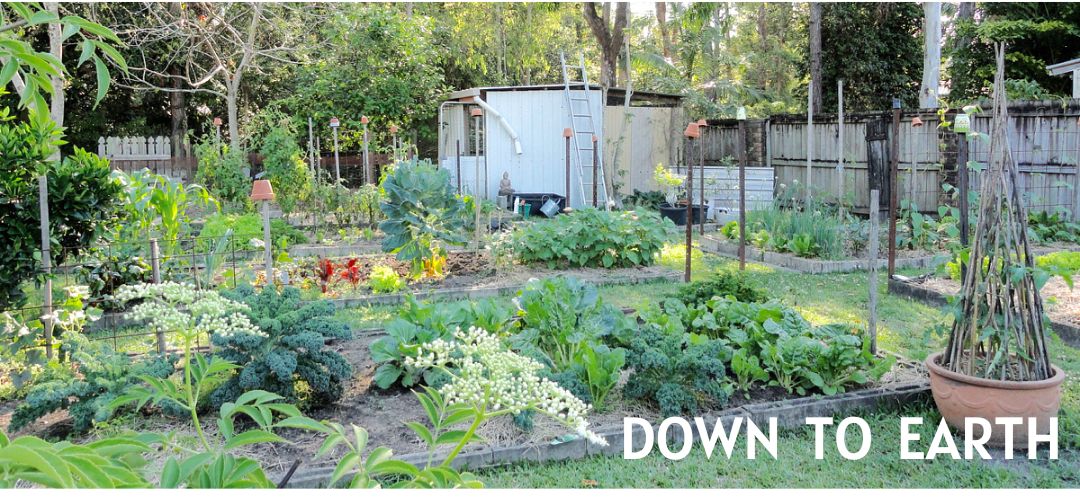Leanne in New Zealand asked if I would write about how we collect water for the garden. It's an important subject this one, especially as Australia is the driest populated continent on the planet. We've been going through the longest drought in our recorded history, many local councils have restricted the amount of water to be used in each house and Australians are looking for ways to cut back on the amount of water they use.
The shires closest to ours are now on level 6 restrictions. That is 140 litres (37 gallons) person per day, with heavy fines for non compliance. That 140 litres includes all water used for drinking, cooking, showering, cleaning, animals and outdoor use. We've never had water restrictions where I live and our dams are usually almost full but we decided a long time ago that water was precious and we shouldn't waste it.
When we moved into our home ten years ago we installed a corrugated iron 5000 litre (1320 gallon) tank. That cost us about $650. We have always used that water on the garden, to wash the car and the dogs and for watering the animals and chooks. I felt comforted knowing that in an emergency, we could also used it as drinking water.
Two years ago, when the drought had settled in and we had emptied our existing tank a couple of times, we installed a larger 10000 litre (2641 gallon) poly tank. This tank cost $1800 but our State government gives rebates and we claimed $1000 cash back. Hanno did our installation which saved a lot of money.
We use the water in both tanks to keep our vegetables and fruit going, to wash the car and the dogs and for all drinking water outside. We also use the rainwater in the tanks exclusively in the aquaponics tank, which constantly recycles 3000 litres of water. This water is topped up from the tanks.
The water that goes into the tanks is collected on the roof of our house. The rainwater runs into gutters connected to downpipes which flow into the tanks. The iron tank is at the south-westerly side of the house and collects water from the back of the house. The poly tank is on the south-easterly of the property, behind our large shed. It collects water from the front of the house and the shed roof. According to Irrigation Warehouse "1mm of rain on every square meter of surface area results in 1 litre of water into the tank. Let's say that your house roof is 12 meters long by 10 meters wide - 12 x 10 = 120 square meters. If you had a very brief storm that dropped 1mm of rain on the roof, you would receive 1mm x 120 sq m = 120 litres of rainfall into the tank. A larger storm comes through and drops 25mm of rain, 25mm (of rain) x 120 (square meters of roof area) = 3,000 litres of rainwater into your tank. This calculation works for any roof area, all you need to know is the length x the width = square meters." We are blessed with good rainfall in our area and in this past year we've been having good storms and fairly frequent showers. This has allowed our tanks to remain between half full and full most of the time, even though we're using the water every day.
Below is the best photo I could get of our back roof. This, my friends, is the roof of people who are trying to do their best to cut back to the bare essentials while living a comfortable life. On our roof at the very top there are two whirlygigs that extract hot air from the roof space simply using wind power. Those grey bumps in the roof - there are three of them, are skylights. We installed them nine years ago so we wouldn't have to turn lights on during the day in dark rooms. On the right - the black ended round tank attached to the sloping panel is our solar hot water system. That went in about five years ago. The gutters on the roof edges are used to collect rainwater. And last, but by no means least, on the left, is a satellite dish for our pay TV. We don't have that service anymore, we gave it up to save money and so we could use the time we were wasting watching TV. I don't want that dish to be removed as it reminds me every day how far we've come and that everyday we have to consciously focus on saving water and electricity.
At the moment, Hanno and I use just over 100 litres of water each a day. We have a 5 star front loading washing machine, I wash dishes by hand, using a sink full of water and a small sink to rinse. We each shower once a day, we do about 3 or 4 loads of washing a week, we drink 2 -3 litres of water each a day. We are now in the habit of only turning on the tap half way, we turn off the water when we're brushing our teeth, we have 3 minute showers and a low flush toilet. Every one of these small measures helps.
Like much in this simple life, water conservation takes a plan and a focused effort. Sure it's a pain to do it at times, but it would be much worse if we had no water.
I'd love to hear your ideas on saving water. What do you do at your place?
FURTHER READING
Saving water in the home
Level 6 water restrictions



